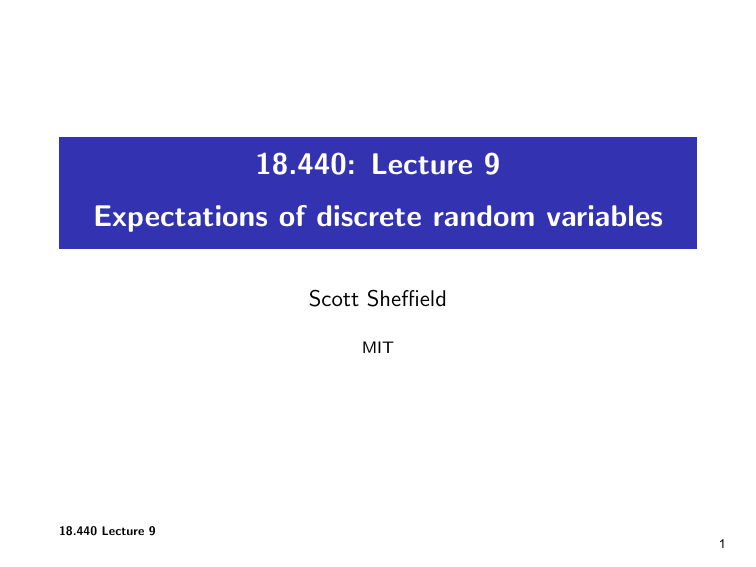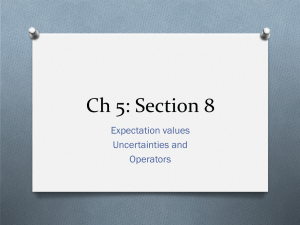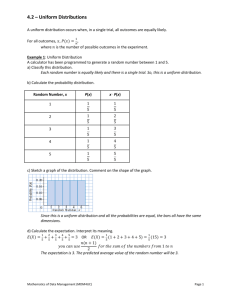Document 13434472
advertisement

18.440: Lecture 9
Expectations of discrete random variables
Scott Sheffield
MIT
18.440 Lecture 9
1
Outline
Defining expectation
Functions of random variables
Motivation
18.440 Lecture 9
2
Outline
Defining expectation
Functions of random variables
Motivation
18.440 Lecture 9
3
Expectation of a discrete random variable
�
Recall: a random variable X is a function from the state space
to the real numbers.
�
Can interpret X as a quantity whose value depends on the
outcome of an experiment.
�
Say X is a discrete random variable if (with probability one)
it takes one of a countable set of values.
�
For each a in this countable set, write p(a) := P{X = a}.
Call p the probability mass function.
�
The expectation of X , written E [X ], is defined by
E [X ] =
xp(x).
x:p(x)>0
�
Represents weighted average of possible values X can take,
each value being weighted by its probability.
18.440 Lecture 9
4
Simple examples
I
�
Suppose that a random variable X satisfies P{X = 1} = .5,
P{X = 2} = .25 and P{X = 3} = .25.
I
�
What is E [X ]?
I
�
Answer: .5 × 1 + .25 × 2 + .25 × 3 = 1.75.
I
�
Suppose P{X = 1} = p and P{X = 0} = 1 − p. Then what
is E [X ]?
I
�
Answer: p.
I
�
Roll a standard six-sided die. What is the expectation of
number that comes up?
I
�
Answer:
16 1 +
16 2 +
16 3 +
16 4 +
16 5 +
16 6 =
18.440 Lecture 9
21
6
= 3.5.
5
Expectation when state space is countable
I�
If the state space S is countable, we can give SUM OVER
STATE SPACE definition of expectation:
X
E [X ] =
P{s}X (s).
s∈S
I�
Compare this to the SUM OVER POSSIBLE X VALUES
definition we gave earlier:
X
E [X ] =
xp(x).
x:p(x)>0
I�
Example: toss two coins. If X is the number of heads, what is
E [X ]?
I�
State space is {(H, H), (H, T ), (T , H), (T , T )} and summing
over state space gives E [X ] = 14 2 + 14 1 + 14 1 + 14 0 = 1.
18.440 Lecture 9
6
A technical point
�
I
If the state
n space S is countable, is it possible that the sum
E [X ] = s∈S P({s})X (s) somehow depends on the order in
which s ∈ S are enumerated?
�
I
In
n principle, yes... We only say expectation is defined when
s∈S P({x})|X (s)| < ∞, in which case it turns out that the
sum does not depend on the order.
18.440 Lecture 9
7
Outline
Defining expectation
Functions of random variables
Motivation
18.440 Lecture 9
8
Outline
Defining expectation
Functions of random variables
Motivation
18.440 Lecture 9
9
Expectation of a function of a random variable
�
I
If X is a random variable and g is a function from the real
numbers to the real numbers then g (X ) is also a random
variable.
�
I
How can we compute E [g (X )]?
�
I
Answer:
E [g (X )] =
X
g (x)p(x).
x:p(x)>0
�
I
Suppose that constants a, b, µ are given and that E [X ] = µ.
�
I
What is E [X + b]?
�
I
How about E [aX ]?
�
I
Generally, E [aX + b] = aE [X ] + b = aµ + b.
18.440 Lecture 9
10
More examples
�
I
Let X be the number that comes up when you roll a standard
six-sided die. What is E [X 2 ]?
�
I
Let Xj be 1 if the jth coin toss isnheads and 0 otherwise.
What is the expectation of X = ni=1 Xj ?
n
Can compute this directly as nk=0 P{X = k}k.
�
I
�
I
Alternatively, use symmetry. Expected number of heads
should be same as expected number of tails.
�
I
This implies E [X ] = E [n − X ]. Applying
E [aX + b] = aE [X ] + b formula (with a = −1 and b = n), we
obtain E [X ] = n − E [X ] and conclude that E [X ] = n/2.
18.440 Lecture 9
11
Additivity of expectation
�
I
If X and Y are distinct random variables, then can one say
that E [X + Y ] = E [X ] + E [Y ]?
�
I
Yes. In fact, for real constants a and b, we have
E [aX + bY ] = aE [X ] + bE [Y ].
�
I
This is called the linearity of expectation.
�
I
Another way to state this fact: given sample space S and
probability measure P, the expectation E [·] is a linear
real-valued function on the space of random variables.
�
I
Can extend to more variables
E [X1 + X2 + . . . + Xn ] = E [X1 ] + E [X2 ] + . . . + E [Xn ].
18.440 Lecture 9
12
More examples
�
Now can we compute expected number of people who get
own hats in n hat shuffle problem?
�
Let Xi be 1 if ith person gets own hat and zero otherwise.
�
What is E [Xi ], for i ∈ {1, 2, . . . , n}?
�
Answer: 1/n.
�
Can write total number with own hat as
X = X1 + X2 + . . . + Xn .
�
Linearity of expectation gives
E [X ] = E [X1 ] + E [X2 ] + . . . + E [Xn ] = n × 1/n = 1.
13
18.440 Lecture 9
Outline
Defining expectation
Functions of random variables
Motivation
18.440 Lecture 9
14
Outline
Defining expectation
Functions of random variables
Motivation
18.440 Lecture 9
15
Why should we care about expectation?
�
I
Laws of large numbers: choose lots of independent random
variables same probability distribution as X — their average
tends to be close to E [X ].
�
I
Example: roll N = 106 dice, let Y be the sum of the numbers
that come up. Then Y /N is probably close to 3.5.
�
I
Economic theory of decision making: Under “rationality”
assumptions, each of us has utility function and tries to
optimize its expectation.
�
I
Financial contract pricing: under “no arbitrage/interest”
assumption, price of derivative equals its expected value in
so-called risk neutral probability.
18.440 Lecture 9
16
Expected utility when outcome only depends on wealth
�
I
Contract one: I’ll toss 10 coins, and if they all come up heads
(probability about one in a thousand), I’ll give you 20 billion
dollars.
�
I
Contract two: I’ll just give you ten million dollars.
�
I
What are expectations of the two contracts? Which would
you prefer?
�
I
Can you find a function u(x) such that given two random
wealth variables W1 and W2 , you prefer W1 whenever
E [u(W1 )] < E [u(W2 )]?
�
I
Let’s assume u(0) = 0 and u(1) = 1. Then u(x) = y means
that you are indifferent between getting 1 dollar no matter
what and getting x dollars with probability 1/y .
18.440 Lecture 9
17
MIT OpenCourseWare
http://ocw.mit.edu
18.440 Probability and Random Variables
Spring 2014
For information about citing these materials or our Terms of Use, visit: http://ocw.mit.edu/terms.




